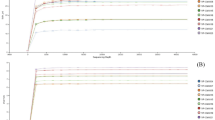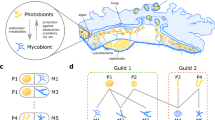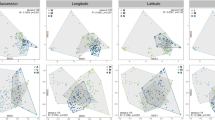Abstract
Lichens are generally considered as mutualisms between fungi and green algae or cyanobacteria. These partnerships allow light-exposed and long-living joint structures. The unique organization of lichens provides still unexplored environments for microbial communities. To study lichen-associated bacterial communities, we analyze samples, by a polyphasic approach, from three lichen species (Cladonia arbuscula, Lecanora polytropa and Umbilicaria cylindrica) from alpine environments. Our results indicate that bacteria can form highly structured, biofilm-like assemblages on fungal surfaces and reach considerable abundances of up to 108 cells per gram fresh weight. Fluorescence in situ hybridization reveals the predominance of Alphaproteobacteria. Microbial fingerprints performed by PCR-single-strand conformation polymorphism analysis using universal and group-specific primers show distinct patterns for each lichen species. Characterization of cultivable strains and presence of functional genes in the total fraction suggest the involvement of associated bacteria in nutrient cycling. Ubiquitous nifH genes, which encode the nitrogenase reductase, show a high diversity and are assigned to Alphaproteobacteria and Firmicutes, for example, Paenibacillus. Cultivable strains mainly belonging to the genera Acinetobacter, Bacillus, Burkholderia, Methylobacterium and Paenibacillus show lytic (chitinolytic, glucanolytic, and proteolytic) activities, hormone production (indole-3-acetic acid) as well as phosphate mobilization and antagonistic activity toward other microorganisms. The traditional concept of lichens has to be expanded to consider multiple bacterial partners.
Similar content being viewed by others
Log in or create a free account to read this content
Gain free access to this article, as well as selected content from this journal and more on nature.com
or
References
Amann RI, Binder BJ, Olson RJ, Chisholm SW, Devereux R, Stahl DA . (1990). Combination of 16S rRNA-targeted oligonucleotide probes with flow cytometry for analyzing mixed microbial populations. Appl Environ Microbiol 56: 1919–1925.
Berg G, Krechel A, Ditz M, Faupel A, Ulrich A, Hallmann J . (2005). Comparison of endophytic and ectophytic potato-associated bacterial communities and their antagonistic activity against plant pathogenic fungi. FEMS Microbiol Ecol 51: 215–229.
Berg G, Roskot N, Steidle A, Eberl L, Zock A, Smalla K . (2002). Plant-dependent genotypic and phenotypic diversity of antagonistic rhizobacteria isolated from different Verticillium host plants. Appl Environ Microbiol 68: 3328–3338.
Blackwood CB, Oaks A, Byuer JS . (2005). Phylum- and class-specific PCR primers for general microbial community analysis. Appl Environm Microbiol 71: 6193–6198.
Boustie J, Grube M . (2005). Lichens—a promising source of bioactive secondary metabolites. Pl Gen Res 3: 273–287.
Cardinale M, Puglia AM, Grube M . (2006). Molecular analysis of lichen-associated bacterial communities. FEMS Microbiol Ecol 57: 484–495.
Cardinale M, de Castro Junior J, Müller H, Berg G, Grube M . (2008). In situ analysis of the bacterial community associated with the reindeer lichen Cladonia arbuscula reveals predominance of Alphaproteobacteria. FEMS Microb Ecol 66: 63–71.
Chernin L, Ismailov Z, Haran S, Chet I . (1995). Chitinolytic Enterobacter agglomerans antagonistic to fungal plant pathogens. Appl Environ Microbiol 61: 1720–1726.
Daims H, Brühl A, Amann R, Schleifer KH, Wagner M . (1999). The domain-specific probe EUB338 is insufficient for the detection of all bacteria: development and evaluation of a more comprehensive probe set. Syst Appl Microbiol 22: 434–444.
Davies J, Wang H, Taylor T, Warabi K, Huang X-H, Andersen RJ . (2005). Uncialamycin, a new enediyne antibiotic. Org Lett 7: 5233–5236.
Denton GH, Karlén W . (1973). Lichenometry: its application to Holocene moraine studies in Southern Alaska and Swedish Lapland. Arctic Alpine Res 5: 347–372.
Ellis CJ, Crittenden PD, Scrimgeour CM, Ashcroft CJ . (2005). Translocation of 15N indicates nitrogen recycling in the mat-forming lichen Cladonia portentosa. New Phytol 168: 423–434.
Erhart RD, Bradford RJ, Seviour R, Amann RI, Blackall LL . (1997). Development and use of fluorescent in situ hybridization probes for the detection and identification of Microthrix parvicella in activated sludge. Syst Appl Microbiol 20: 310–318.
Farrar JF . (1985). The lichen as an ecosystem: observation and experiment. In: Brown DH, Hawksworth DL, Bailey RH (eds). Lichenology: Progress and Problems. Academic Press: London, pp 385–406.
Felsenstein J . (2004). PHYLIP (Phylogeny Inference Package) version 3.6. Distributed by the author Department of Genome Sciences, University of Washington, Seattle.
Francolini I, Norris P, Piozzi A, Donelli G, Stoodley P . (2004). Usnic acid, a natural antimicrobial agent able to inhibit bacterial biofilm formation on polymer surfaces. Antimicrob Agents Chemother 48: 4360–4365.
Gonzáles I, Ayuso-Sacido A, Anderson A, Genilloud O . (2005). Actinomycetes isolated from lichens: evaluation of their diversity and detection of biosynthetic gene sequences. FEMS Microbiol Ecol 54: 401–415.
Grube M, Hawksworth DL . (2007). Trouble with lichen: the re-evaluation and re-interpretation of thallus form and fruit body types in the molecular era. Mycol Res 111: 1116–1132.
Grube M, Berg G . (2009). Bacterial associations with fungi, focusing on the lichen symbiosis. Fungal Biol Rev (in press).
Hansen SK, Rainey RB, Haagensen JAJ, Molin S . (2007). Evolution of species interactions in a biofilm community. Nature 445: 533–536.
Hawksworth DL . (1988). The variety of fungal–algal symbioses, their evolutionary significance, and the nature of lichens. Bot J Linn Soc 96: 3–20.
Henkel PA, Plotnikova TT . (1973). Nitrogen-fixing bacteria in lichens. Izv Akad Nauk Ser Biol 1973: 807–813.
Henkel PA, Yuzhakova LA . (1936). Nitrogen-fixing bacteria in lichens. Izv Biol Inst Permsk Gos Univ 10: 9–10.
Hunter P . (2006). Entente cordiale: multiple symbiosis illustrates the intricate interconnectivity of nature. EMBO Rep 7: 861–864.
Ingólfsdóttir K . (2002). Usnic acid. Phytochem 61: 729–736.
Iskina RY . (1938). On nitrogen fixing bacteria in lichens. Isv Biol Inst Permsk 11: 133–139.
Kneip C, Lockhart P, Voss C, Maier UG . (2007). Nitrogen fixation in eukaryotes—new models for symbiosis. BMC Evol Biol 7: 55.
Kropf S, Heuer H, Grüning, Smalla K . (2004). Significance test for comparing complex microbial community fingerprints using pairwise similarity measures. J Microbiol Methods 57: 187–195.
Lawrey JD, Diederich P . (2003). Lichenicolous fungi: interactions, evolution, and biodiversity. Bryologist 106: 81–120.
Lenova LI, Blum O . (1983). To the question on the third component of lichens. Bot J 68: 21–28.
Liba CM, Ferrara FIS, Mangio GP, Fantinatti-Garboggini F, Albuquerque RC, Pavan C et al. (2006). Nitrogen-fixing chemo-organotrophic bacteria isolated from cyanobacteria-deprived lichens and their ability to solubilize phosphate and to release amino acids and phytohormones. J Appl Microbiol 101: 1076–1086.
Loy A, Maixner F, Wagner M, Horn M . (2007). probeBase—an online resource for rRNA-targeted oligonucleotide probes: new features 2007. Nucleic Acids Res 35: D800–D804.
Lutzoni F, Pagel M, Reeb V . (2001). Major fungal lineages are derived from lichen symbiotic ancestors. Nature 411: 937–940.
Manz W, Amann R, Ludwig W, Wagner M, Schleifer KH . (1992). Phylogenetic oligodeoxynucleotide probes for the major subclasses of proteobacteria: problems and solutions. Syst Appl Microbiol 15: 593–600.
Meier H, Amann R, Ludwig W, Schleifer KH . (1999). Specific oligonucleotide probes for in situ detection of a major group of Gram-positive bacteria with low DNA G1C content. Syst Appl Microbiol 22: 186–196.
Nautiyal CS . (1999). An efficient microbiological growth medium for screening phosphate solubilizing microorganisms. FEMS Microbiol Ecol 170: 265–270.
Opelt K, Berg G . (2004). Diversity and antagonistic potential of bacteria associated with bryophytes from nutrient-poor habitats of the Baltic Sea Coast. Appl Environ Microbiol 70: 6569–6579.
Page RD . (1996). TreeView: an application to display phylogenetic trees on personal computers. Comput Appl Biosci 12: 357–358.
Panosyan AK, Nikogosyan VG . (1966). The presence of Azotobacter in lichens. Akad Nauk Armian SSR Biol Zhurn Armen 19: 3–11.
Ryan RP, Germaine K, Franks A, Ryan DJ, Dowling DN . (2008). Bacterial endophytes: recent developments and applications. FEMS Microbiol Lett 278: 1–9.
Sawar M, Kremer RJ . (1995). Determination of bacterially derived auxins using a microplate method. Lett Appl Microbiol 20: 282–285.
Schwieger F, Tebbe CC . (1998). A new approach to utilize PCR-single-strand-conformation polymorphism for 16S rRNA gene-based microbial community analysis. Appl Environ Microbiol 64: 4870–4876.
Scott GD . (1956). Further investigations of some lichens for fixation of nitrogen. New Phytol 55: 111–116.
Seneviratne G, Indrasena IK . (2006). Nitrogen fixation in lichens is important for improved rock weathering. J Biosci 31: 639–643.
Thompson JD, Higgins DG, Gibson TJ . (1994). CLUSTAL W: improving the sensitivity of progressive multiple sequence alignment through sequence weighting, position-specific gap penalties and weight matrix choice. Nucleic Acids Res 22: 4673–4680.
Wallner G, Amann R, Beisker W . (1993). Optimizing fluorescent in situ hybridization with rRNA-targeted oligonucleotide probes for flow cytometric identification of microorganisms. Cytometry 14: 136–143.
Yeager C, Kornosky JL, Housman DC, Grote EE, Belnap J, Kuske CR . (2004). Diazotrophic community structure and function in two successional stages of biological soil crusts from the Colorado plateau and Chihuahuan desert. Appl Environ Microbiol 70: 973–983.
Yuan X, Xiao S, Taylor TN . (2005). Lichen-like symbiosis 600 million years ago. Science 308: 1017–1020.
Acknowledgements
We thank David Hawksworth, Ilse Kranner and Martin Hagemann for comments. This research was funded by a grant from the Austrian Science Foundation (FWF) to MG and GB.
Author information
Authors and Affiliations
Corresponding author
Rights and permissions
About this article
Cite this article
Grube, M., Cardinale, M., de Castro, J. et al. Species-specific structural and functional diversity of bacterial communities in lichen symbioses. ISME J 3, 1105–1115 (2009). https://doi.org/10.1038/ismej.2009.63
Received:
Revised:
Accepted:
Published:
Issue date:
DOI: https://doi.org/10.1038/ismej.2009.63
Keywords
This article is cited by
-
Patterns and predictors of lichen rarity in a biodiversity hotspot
Biodiversity and Conservation (2024)
-
Gill-associated bacteria are homogeneously selected in amphibious mangrove crabs to sustain host intertidal adaptation
Microbiome (2023)
-
Tackling fungal diversity in lichen symbioses: molecular and morphological data recognize new lineages in Chaetothyriales (Eurotiomycetes, Ascomycota)
Mycological Progress (2023)
-
Plant organ- and growth stage-diversity of endophytic bacteria with potential as biofertilisers isolated from wheat (Triticum aestivum L.)
BMC Plant Biology (2022)
-
Metagenomic analysis of lichen-associated bacterial community profiling in Roccella montagnei
Archives of Microbiology (2022)



